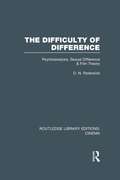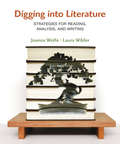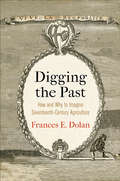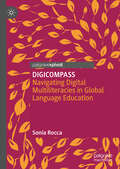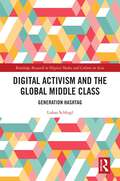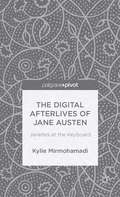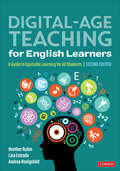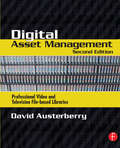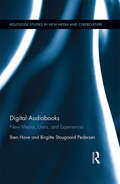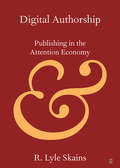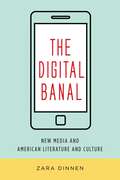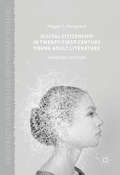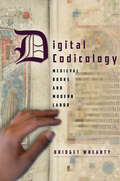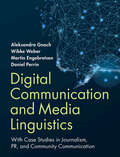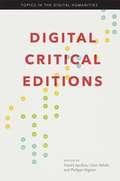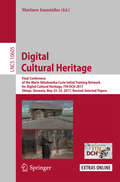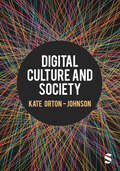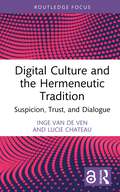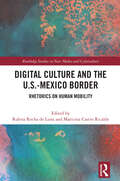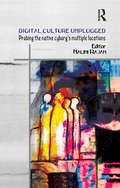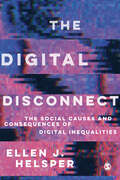- Table View
- List View
The Difficulty of Difference: Psychoanalysis, Sexual Difference and Film Theory (Routledge Library Editions: Cinema)
by D. N. RodowickThis book argues that serious misreadings of Freud and Lacan on sexual difference have characterized prevailing models of psychoanalytic film criticism. In critiquing theories of identification and female spectatorship, the author maintains that early film theorists and feminist critics are equally guilty of imposing a binary conception of sexual difference on Freud’s thought. By embracing such a rigid definition of male/female difference, they fail to understand the fundamentally complex and fluid process of sexual identification as it is articulated in Freud’s writing, constructed in film texts, and negotiated by spectators. The book turns to Freud’s work on fantasy to develop an alternative model for interpreting sexuality in the visual and narrative arts, one that emphasizes a ‘politics of critical reading’ over accepted theories of ideological identification. Originally published in 1991, its strategic focus on psychoanalysis itself as an object of historical and critical inquiry, and not simply as a reading method is the unique quality of this book.
Digging into Literature Strategies for Reading, Analysis, and Writing
by Joanna Wolfe Laura WilderPACKAGE THIS TITLE WITH OUR 2016 MLA SUPPLEMENT, Documenting Sources in MLA Style (package ISBN-13: 9781319084844). Get the most recent updates on MLA citation in a convenient, 40-page resource based on The MLA Handbook, 8th Edition, with plenty of models. Browse our catalog or contact your representative for a full listing of updated titles and packages, or to request a custom ISBN. Digging into Literature reveals the critical strategies that any college student can use for reading, analyzing, and writing about literary texts. The authors' unique approach is based on groundbreaking studies of the successful interpretive and rhetorical moves of hundreds of professional and student essays. Full of practical charts and summaries-- with plenty of exercises and activities for trying out the strategies-- the book convincingly reveals that while great literature is complex, writing effective essays about it doesn't have to be.
Digging the Past: How and Why to Imagine Seventeenth-Century Agriculture (Haney Foundation Series)
by Frances E. DolanA detailed study of seventeenth century farming practices and their relevance for todayWe are today grappling with the consequences of disastrous changes in our farming and food systems. While the problems we face have reached a crisis point, their roots are deep. Even in the seventeenth century, Frances E. Dolan contends, some writers and thinkers voiced their reservations, both moral and environmental, about a philosophy of improvement that rationalized massive changes in land use, farming methods, and food production. Despite these reservations, the seventeenth century was a watershed in the formation of practices that would lead toward the industrialization of agriculture. But it was also a period of robust and inventive experimentation in what we now think of as alternative agriculture. This book approaches the seventeenth century, in its failed proposals and successful ventures, as a resource for imagining the future of agriculture in fruitful ways. It invites both specialists and non-specialists to see and appreciate the period from the ground up.Building on and connecting histories of food and work, literary criticism of the pastoral and georgic, histories of elite and vernacular science, and histories of reading and writing practices, among other areas of inquiry, Digging the Past offers fine-grained case studies of projects heralded as innovations both in the seventeenth century and in our own time: composting and soil amendment, local food, natural wine, and hedgerows. Dolan analyzes the stories seventeenth-century writers told one another in letters, diaries, and notebooks, in huge botanical catalogs and flimsy pamphlets, in plays, poems, and how-to guides, in adages and epics. She digs deeply to assess precisely how and with what effect key terms, figurations, and stories galvanized early modern imaginations and reappear, often unrecognized, on the websites and in the tour scripts of farms and vineyards today.
DIGICOMPASS: Navigating Digital Multiliteracies in Global Language Education
by Sonia RoccaThis book addresses the urgent need for an educational framework that integrates digital multiliteracies with global competence. As technology reshapes how we communicate, learn, and work, educators face the challenge of preparing students not just academically but as informed, ethical participants in a digital and global community. Furthermore, as classrooms become more culturally diverse, the importance of inclusive practices and intercultural competence cannot be overstated. The author sets out to resolve a gap in current educational practices that often separate technology integration, language learning, and global education into distinct compartments. This separation fails to equip learners with the holistic skill set required in the 21st century. The book proposes a transformative approach that synergizes these elements, presenting a comprehensive curriculum framework designed to cultivate digitally literate, globally competent, and socially responsible individuals. By providing practical strategies, theoretical foundations, and real-world applications, DIGICOMPASS aims to revolutionize global language education. It not only advocates for the integration of adaptive learning technologies and digital multiliteracies but also emphasizes the importance of fostering an inclusive, culturally aware, and ethically engaged learning environment. This comprehensive approach addresses the modern educational landscape's complexities, preparing learners to thrive in a culturally diverse and digitally interconnected world. The book will be of particular interest to educators, curriculum developers, policymakers, and educational technology specialists interested in integrating digital multiliteracies into language education. It will also appeal to scholars and students in the fields of TESOL, educational technology, global education, and curriculum design.
Digital Activism and the Global Middle Class: Generation Hashtag (Routledge Research in Digital Media and Culture in Asia)
by Lukas SchloglThis book examines the causes of a growing wave of digital activism across developing countries, arguing that it is driven by social change, rather than technological advancement alone. Beginning with an investigation into the modernisation of ‘middle-income countries’ and its ramifications for political culture, the book examines large-scale social media protest during political controversies in Indonesia. The book connects empirical evidence to classic theories of value change and political behaviour. It departs from a narrow ‘digital divide’ framing whereby Internet access produces Internet activism. It introduces the concepts of ‘digital self-expression’ and of ‘middle-class struggles’ to capture the value-stratified nature of political engagement in the online sphere. Drawing on a blend of ‘big-data’ text analyses, representative opinion research and socioeconomic household analyses, a rich picture of the determinants of digital activism emerges. This truly cross-disciplinary book will appeal particularly to students and scholars in Political Science, Sociology, International Development, and Communication, but also to anyone eager to learn about political activism, social transformation, and new media from a global perspective.
The Digital Afterlives of Jane Austen: Janeites at the Keyboard
by Kylie MirmohamadiThis is the first scholarly study to explore the ever-expanding world of online Austen fandom and fan fiction writing. Using case studies from the Internet writing community and publisher, Wattpad, as well as dedicated fan websites, it illuminates the literary processes and products that have given Austen multiple afterlives in the digital arena.
Digital-Age Teaching for English Learners: A Guide to Equitable Learning for All Students
by Lisa M. Estrada Andrea Honigsfeld Heather RubinBridge the Digital Divide with Research-Informed Technology Models Since the first edition of this bestselling resource many schools are still striving to close the digital divide and bridge the opportunity gap for historically marginalized students, including English learners. And the need for technology-infused lessons specifically aligned for English learners is even more critically needed. Building from significant developments in education policy, research, and remote learning innovations, this newly revised edition offers unique ways to bridge the digital divide that disproportionally affects culturally and linguistically diverse learners. Designed to support equitable access to engaging and enriching digital-age education opportunities for English learners, this book includes Research-informed and evidence-based technology integration models and instructional strategies Sample lesson ideas, including learning targets for activating students’ prior knowledge while promoting engagement and collaboration Tips for fostering collaborative practices with colleagues Vignettes from educators incorporating technology in creative ways Targeted questions to facilitate discussions about English language development methodology Complete with supplementary tools and resources, this guide provides all of the methodology resources needed to bridge the digital divide and promote learning success for all students.
Digital-Age Teaching for English Learners: A Guide to Equitable Learning for All Students
by Lisa M. Estrada Andrea Honigsfeld Heather RubinBridge the Digital Divide with Research-Informed Technology Models Since the first edition of this bestselling resource many schools are still striving to close the digital divide and bridge the opportunity gap for historically marginalized students, including English learners. And the need for technology-infused lessons specifically aligned for English learners is even more critically needed. Building from significant developments in education policy, research, and remote learning innovations, this newly revised edition offers unique ways to bridge the digital divide that disproportionally affects culturally and linguistically diverse learners. Designed to support equitable access to engaging and enriching digital-age education opportunities for English learners, this book includes Research-informed and evidence-based technology integration models and instructional strategies Sample lesson ideas, including learning targets for activating students’ prior knowledge while promoting engagement and collaboration Tips for fostering collaborative practices with colleagues Vignettes from educators incorporating technology in creative ways Targeted questions to facilitate discussions about English language development methodology Complete with supplementary tools and resources, this guide provides all of the methodology resources needed to bridge the digital divide and promote learning success for all students.
Digital Asset Management
by David AusterberryThe second edition focuses on the media and entertainment sector (M&E), with more information relevant to encompass broadcasters migration to file-based production. New technology and new products are also included and there is more detail on systems integration and product examples, plus extra case studies. New content includes:- Storage management where several products have been designed for the special needs of the media business.- XML and web services.- New case studies.
Digital Audiobooks: New Media, Users, and Experiences (Routledge Studies in New Media and Cyberculture)
by Iben Have Birgitte Stougaard PedersenAudiobooks are rapidly gaining popularity with widely accessible digital downloading and streaming services. This book engages with the digital form of audiobooks, framing audiobook listening as both a remediation of literature and an everyday activity that creates new reading experiences that can be compared to listening to music or the radio. Have and Stougaard Pedersen challenge the historical notion that audiobook listening is a compensatory activity or a second-rate reading experience, while seeking to establish a dialogue between sound studies and media studies, comparative literature, aesthetics, and sociology.
Digital Authorship: Publishing in the Attention Economy (Elements in Publishing and Book Culture)
by R. Lyle SkainsThis Element looks at contemporary authorship via three key authorial roles: indie publisher, hybrid author, and fanfiction writer. The twenty-first century's digital and networked media allows writers to disintermediate the established structures of royalty publishing, and to distribute their work directly to - and often in collaboration with - their readers. This demotic author, one who is 'of the people', often works in genres considered 'popular' or 'derivative'. The demotic author eschews the top-down communication flow of author > text > reader, in favor of publishing platforms that generate attention capital, such as blogs, fanfiction communities, and social media.
The Digital Banal: New Media and American Literature and Culture (Literature Now)
by Zara DinnenContemporary culture is haunted by its media. Yet in their ubiquity, digital media have become increasingly banal, making it harder for us to register their novelty or the scope of the social changes they have wrought. What do we learn about our media environment when we look closely at the ways novelists and filmmakers narrate and depict banal use of everyday technologies? How do we encounter our own media use in scenes of waiting for e-mail, watching eBay bids, programming as work, and worrying about numbers of social media likes, friends, and followers?Zara Dinnen analyzes a range of prominent contemporary novels, films, and artworks to contend that we live in the condition of the “digital banal,” not noticing the affective and political novelty of our relationship to digital media. Authors like Jennifer Egan, Dave Eggers, Sheila Heti, Jonathan Lethem, Gary Shteyngart, Colson Whitehead, Mark Amerika, Ellen Ullman, and Danica Novgorodoff and films such as The Social Network and Catfish critique and reveal the ways in which digital labor isolates the individual; how the work of programming has become an operation of power; and the continuation of the “Californian ideology,” which has folded the radical into the rote and the imaginary into the mundane. The works of these writers and artists, Dinnen argues, also offer ways of resisting the more troubling aspects of the effects of new technologies, as well as timely methods for seeing the digital banal as a politics of suppression. Bridging the gap between literary studies and media studies, The Digital Banal recovers the shrouded disturbances that can help us recognize and antagonize our media environment.
Digital Carnivalesque: Power Discourse and Counter Narratives in Singapore Social Media (Cultural Studies and Transdisciplinarity in Education #10)
by Hoi-Yi Katy KanThis book challenges the framing of comedic acts as apolitical and it adopts a multimodal critical discourse approach to interrogate the performance of comedy as a form of power. It proposes using Bakhtin’s carnivalesque as the analytic tool to distil for readers key differences between humour as banal and humour as critical (and political) in today’s social media. Drawing from critical theory and cultural studies, this book takes an interdisciplinary approach in formulating a contemporary view of power that reflects social realities not only in the digital economy but also in a world that is increasingly authoritarian. With the proposition of newer theoretical lenses in this book, scholars and social scientists can then find a way to shift the conversation to uncover the evolving voices of (existing and newer) power holders in the shared digital space; and to view current social realities as a continual project in unpacking and understanding the adaptive ways of the human spirit.
Digital Citizenship in Twenty-First-Century Young Adult Literature
by Megan L. MusgraveThis book is a study of the evolving relationships between literature, cyberspace, and young adults in the twenty-first century. Megan L. Musgrave explores the ways that young adult fiction is becoming a platform for a public conversation about the great benefits and terrible risks of our increasing dependence upon technology in public and private life. Drawing from theories of digital citizenship and posthuman theory, Digital Citizenship in Twenty-First Century Young Adult Literature considers how the imaginary forms of activism depicted in literature can prompt young people to shape their identities and choices as citizens in a digital culture
Digital Codicology: Medieval Books and Modern Labor (Stanford Text Technologies)
by Bridget WheartyMedieval manuscripts are our shared inheritance, and today they are more accessible than ever—thanks to digital copies online. Yet for all that widespread digitization has fundamentally transformed how we connect with the medieval past, we understand very little about what these digital objects really are. We rarely consider how they are made or who makes them. This case study-rich book demystifies digitization, revealing what it's like to remake medieval books online and connecting modern digital manuscripts to their much longer media history, from print, to photography, to the rise of the internet. Examining classic late-1990s projects like Digital Scriptorium 1.0 alongside late-2010s initiatives like Bibliotheca Philadelphiensis, and world-famous projects created by the British Library, Corpus Christi College Cambridge, Stanford University, and the Walters Art Museum against in-house digitizations performed in lesser-studied libraries, Whearty tells never-before-published narratives about globally important digital manuscript archives. Drawing together medieval literature, manuscript studies, digital humanities, and imaging sciences, Whearty shines a spotlight on the hidden expert labor responsible for today's revolutionary digital access to medieval culture. Ultimately, this book argues that centering the modern labor and laborers at the heart of digital cultural heritage fosters a more just and more rigorous future for medieval, manuscript, and media studies.
Digital Communication and Media Linguistics: With Case Studies in Journalism, PR, and Community Communication
by Aleksandra Gnach Wibke Weber Martin Engebretsen Daniel PerrinThis textbook offers an interdisciplinary, comprehensive and state-of-the-art overview of the media linguistics approaches to explain and understand digital communication and multimodality. Linking the fields of communication studies, applied linguistics and journalism, it grounds communication practices in a deep understanding of the social and societal implications of language use in digital media. The tools to analyse multimodal texts are analysed in light of the advantages and constraints that different communication modes pose, both individually and in combination. Aimed at upper level undergraduates and graduates in applied linguistics, communication and media studies, including journalism and PR, this textbook contains case studies and professional examples highlighting the interplay between language use and digital communication and encouraging the reader to reflect on the themes covered, and put the acquired knowledge into practice. Online resources for students include videos, writing techniques, a guide to multimodal texts analysis, additional case studies and a glossary.
Digital Critical Editions
by Claire Belisle Philippe Regnier Daniel ApollonProvocative yet sober, Digital Critical Editions examines how transitioning from print to a digital milieu deeply affects how scholars deal with the work of editing critical texts. On one hand, forces like changing technology and evolving reader expectations lead to the development of specific editorial products, while on the other hand, they threaten traditional forms of knowledge and methods of textual scholarship. Using the experiences of philologists, text critics, text encoders, scientific editors, and media analysts, Digital Critical Editions ranges from philology in ancient Alexandria to the vision of user-supported online critical editing, from peer-directed texts distributed to a few to community-edited products shaped by the many. The authors discuss the production and accessibility of documents, the emergence of tools used in scholarly work, new editing regimes, and how the readers' expectations evolve as they navigate digital texts. The goal: exploring questions such as, What kind of text is produced? Why is it produced in this particular way? Digital Critical Editions provides digital editors, researchers, readers, and technological actors with insights for addressing disruptions that arise from the clash of traditional and digital cultures, while also offering a practical roadmap for processing traditional texts and collections with today's state-of-the-art editing and research techniques thus addressing readers' new emerging reading habits.
Digital Cultural Heritage: Progress In Cultural Heritage. Documentation, Preservation, And Protection5th International Conference, Euromed 2014, Limassol, Cyprus, November 3-8, 2014, Proceedings (Theoretical Computer Science and General Issues #8740)
by Marinos IoannidesThis book constitutes the refereed post-conference proceedings of the Final Conference of the Marie Skłodowska-Curie Initial Training Network for Digital Cultural Heritage, held in Olimje, Slovenia, in May 2017.The 29 revised full papers included in this volume were carefully reviewed and selected from 198 submissions. They focus on interdisciplinary and multi-disciplinary research concerning cutting edge cultural heritage informatics, -physics, -chemistry and -engineering and the use of technology for the representation, documentation, archiving, protection, preservation and communication of cultural heritage knowledge.
Digital Culture and Society
by Kate Orton-JohnsonThis book provides a critical introduction to the ways in which digital technologies have enabled new types of interactions, experiences and collaborations across a range of platforms and media, profoundly shaping our socio-cultural landscapes. These discussions are grounded in classical sociological concepts; community, the self, gender, consumption, power and exclusion and inequality, to demonstrate the continuities that exist between sociological studies of ‘real’ world phenomena and their digital counterparts. Examining the various debates around methods in digital sociology in recent years, this book provides an accessible and engaging guide to using methodologies to study digital technology. From the moment we wake up until we go to bed, many of us constantly use digital technologies. Our mobile phones have become our maps, banks, newspapers and entertainment consoles. What′s more, they allow us to be constantly connected with the people in our lives. This book will equip you to analyse digital media in your own work. The book offers a broad guide to the various areas of our lives that are impacted by digital technology, from the virtual communities that we form on social media to the impact that digital technology has on our identity through a ′sociology of selfies′. With chapters on leisure, work, privacy and methods, this is an essential introduction for students in the areas of sociology, digital media, and cultural studies. Learning features include: - Annotated further reading in every chapter - Case studies that illustrate theory - Learning objectives and questions throughout - Historical and theoretical context in every chapter
Digital Culture and Society
by Kate Orton-JohnsonThis book provides a critical introduction to the ways in which digital technologies have enabled new types of interactions, experiences and collaborations across a range of platforms and media, profoundly shaping our socio-cultural landscapes. These discussions are grounded in classical sociological concepts; community, the self, gender, consumption, power and exclusion and inequality, to demonstrate the continuities that exist between sociological studies of ‘real’ world phenomena and their digital counterparts. Examining the various debates around methods in digital sociology in recent years, this book provides an accessible and engaging guide to using methodologies to study digital technology. From the moment we wake up until we go to bed, many of us constantly use digital technologies. Our mobile phones have become our maps, banks, newspapers and entertainment consoles. What′s more, they allow us to be constantly connected with the people in our lives. This book will equip you to analyse digital media in your own work. The book offers a broad guide to the various areas of our lives that are impacted by digital technology, from the virtual communities that we form on social media to the impact that digital technology has on our identity through a ′sociology of selfies′. With chapters on leisure, work, privacy and methods, this is an essential introduction for students in the areas of sociology, digital media, and cultural studies. Learning features include: - Annotated further reading in every chapter - Case studies that illustrate theory - Learning objectives and questions throughout - Historical and theoretical context in every chapter
Digital Culture and the Hermeneutic Tradition: Suspicion, Trust, and Dialogue (Routledge Focus on Literature)
by Inge van de Ven Lucie ChateauIn our information age, deciding what sources and voices to trust is a pressing matter. There seems to be a surplus of both trust and distrust in and on platforms, both of which often amount to having your mindset remain the same. Can we move beyond this dichotomy toward new forms of intersubjective dialogue? This book revaluates the hermeneutic tradition for the digital context. Today, hermeneutics has migrated from a range of academic approaches into a plethora of practices in digital culture at large. We propose a ‘scaled reading’ of such practices: a reconfiguration of the hermeneutic circle, using different tools and techniques of reading. We demonstrate our digital-hermeneutic approach through case studies including toxic depression memes, the Johnny Depp/Amber Heard trial, and r/changemyview. We cover three dimensions of hermeneutic practice: suspicion, trust, and dialogue. This book is essential reading for (under)graduate students in digital humanities and literary studies.
Digital Culture and the U.S.-Mexico Border: Rhetorics on Human Mobility (Routledge Studies in New Media and Cyberculture)
by Rubria Rocha de Luna Maricruz Castro RicaldeConceptualizing how digital artifacts can function as a frontier mediated by technology in the geographical, physical, sensory, visual, discursive, and imaginary, this volume offers an interdisciplinary analysis of digital material circulating online in a way that creates a digital dimension of the Mexico-U.S. border.In the context of a world where digital media has helped to shape geopolitical borders and impacted human mobility in positive and negative ways, the book explores new modes of expression in which identification, memory, representation, persuasion, and meaning-making are created, experienced, and/or circulated through digital technologies. An interdisciplinary team of scholars looks at how quick communications bring closer transnational families and how online resources can be helpful for migrants, but also at how digital media can serve to control and reinforce borders via digital technology used to create a system of political control that reinforces stereotypes. The book deconstructs digital artifacts such as the digital press, social media, digital archives, web platforms, technological and artistic creations, visual arts, video games, and artificial intelligence to help us understand the anti-immigrant and dehumanizing discourse of control, as well as the ways migrants create vernacular narratives as digital activism to break the stereotypes that afflict them.This timely and insightful volume will interest scholars and students of digital media, communication studies, journalism, migration, and politics.
Digital Culture Unplugged: Probing the Native Cyborg’s Multiple Locations
by Nalini RajanFirst published in 2007. Routledge is an imprint of Taylor & Francis, an informa company.
The Digital Disconnect: The Social Causes and Consequences of Digital Inequalities
by Ellen HelsperWith the increased digitisation of society comes an increased concern about who is left behind. From societal causes to the impact of everyday actions, The Digital Disconnect explores the relationship between digital and social inequalities, and the lived consequences of digitisation. Ellen Helsper goes beyond questions of digital divides and who is connected. She asks why and how social and digital inequalities are linked and shows the tangible outcomes of socio-digital inequalities in everyday lives. The book: Introduces the key theories and concepts needed to understand both ‘traditional’ and digital inequalities research. Investigates a range of socio-digital inequalities, from digital access and skills, to civic participation, social engagement, and everyday content creation and consumption. Brings research to life with a range of qualitative vignettes, drawing out the personal experiences that lay at the heart of global socio-digital inequalities. The Digital Disconnect is an expert exploration of contemporary theory, research and practice in socio-digital inequalities. It is also an urgent and impassioned call to broaden horizons, expand theoretical and methodological toolkits, and work collectively to help achieve a fairer digital future for all. Ellen J. Helsper is Professor of Digital Inequalities at the Department of Media and Communications at London School of Economics and Political Science.
The Digital Disconnect: The Social Causes and Consequences of Digital Inequalities
by Ellen HelsperWith the increased digitisation of society comes an increased concern about who is left behind. From societal causes to the impact of everyday actions, The Digital Disconnect explores the relationship between digital and social inequalities, and the lived consequences of digitisation. Ellen Helsper goes beyond questions of digital divides and who is connected. She asks why and how social and digital inequalities are linked and shows the tangible outcomes of socio-digital inequalities in everyday lives. The book: Introduces the key theories and concepts needed to understand both ‘traditional’ and digital inequalities research. Investigates a range of socio-digital inequalities, from digital access and skills, to civic participation, social engagement, and everyday content creation and consumption. Brings research to life with a range of qualitative vignettes, drawing out the personal experiences that lay at the heart of global socio-digital inequalities. The Digital Disconnect is an expert exploration of contemporary theory, research and practice in socio-digital inequalities. It is also an urgent and impassioned call to broaden horizons, expand theoretical and methodological toolkits, and work collectively to help achieve a fairer digital future for all. Ellen J. Helsper is Professor of Digital Inequalities at the Department of Media and Communications at London School of Economics and Political Science.
